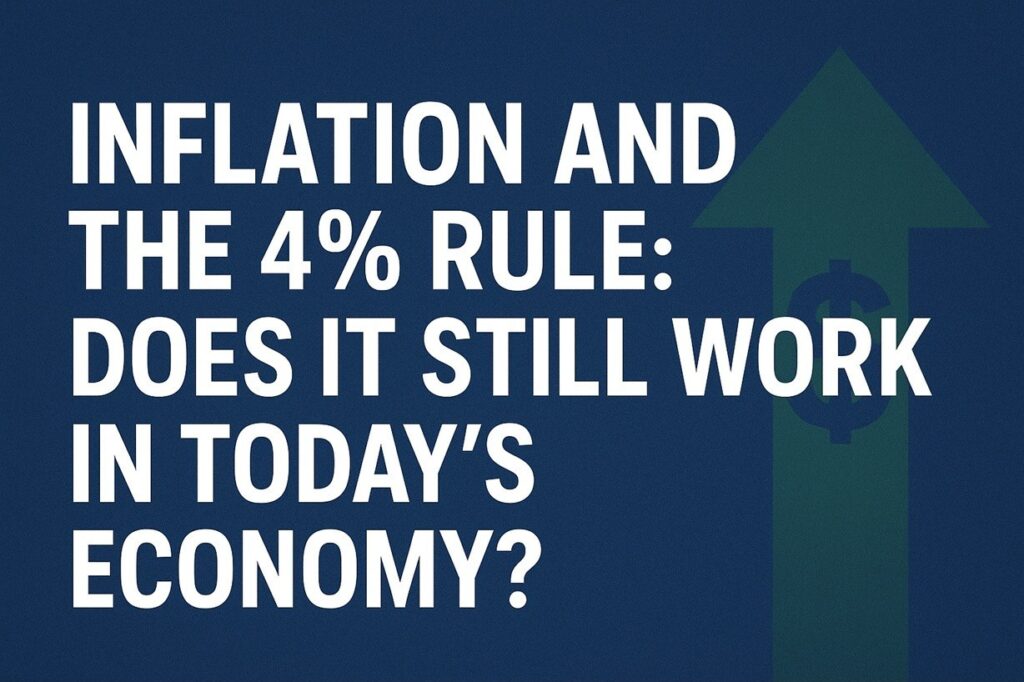
Understanding the 4% Rule
For decades, the 4% rule has served as a simple guideline for retirees: withdraw 4% of your retirement savings in the first year, then adjust that amount annually for inflation. The idea is that this withdrawal strategy should sustain a portfolio for 30 years.
But with inflation at levels not seen in decades, rising interest rates, and increased market volatility, retirees are asking: Does the 4% rule still work?
As a fiduciary advisor, my goal is to help clients evaluate whether this traditional guideline is still a safe approach—or if adjustments are needed to protect their retirement lifestyle.
Why Inflation Challenges the 4% Rule
Inflation directly impacts retirees because it erodes the purchasing power of fixed withdrawals. Let’s look at why the rule faces pressure today:
- Higher Living Costs: Groceries, healthcare, and housing expenses are increasing faster than many retirees anticipated.
- Market Volatility: Sequence-of-returns risk—poor market performance early in retirement—can quickly drain savings.
- Longevity Risk: Retirees are living longer, meaning portfolios must last 30–35 years or more.
When inflation rises above historical averages, a 4% annual withdrawal may no longer be sufficient—or sustainable.
Rethinking Retirement Withdrawals
Rather than relying on one rule of thumb, a more personalized, fiduciary-guided strategy may be better. Here are approaches worth considering:
- Dynamic Withdrawal Strategies
Instead of fixed 4% withdrawals, retirees can adjust spending based on market performance and inflation levels. This flexibility can help extend portfolio longevity.
- The Bucket Strategy
Segmenting retirement savings into short-term, medium-term, and long-term “buckets” ensures that immediate expenses are covered while growth assets are given time to recover from volatility.
- Income Laddering with Annuities or Bonds
Creating a predictable stream of income through annuities or bond ladders can reduce reliance on market withdrawals during inflationary periods.
- Diversification into Inflation-Resilient Assets
TIPS (Treasury Inflation-Protected Securities), real estate, and certain equities can help offset the impact of rising prices.
The Fiduciary Perspective
As fiduciary advisors, we must move beyond outdated rules of thumb and instead create customized withdrawal strategies aligned with each client’s:
- Risk tolerance
- Time horizon
- Income needs
- Legacy goals
The 4% rule may serve as a starting point, but retirees today need a plan that considers inflation, longevity, and market realities.
Conclusion
Inflation has made retirement income planning more complex, and the 4% rule—while once a helpful guideline—may not be reliable on its own in today’s economy.
A well-structured, inflation-resilient retirement plan should adapt to market conditions and provide the flexibility retirees need to preserve their lifestyle.
Call to Action
If you’re wondering whether your retirement withdrawal strategy is sustainable in today’s inflationary environment, now is the time to revisit your plan.
Contact me today for a fiduciary review of your retirement income strategy—so you can retire with confidence, regardless of economic conditions.
Global View Capital Management (GVCM) is an affiliate of Global View Capital Advisors (GVCA). GVCM is a SEC Registered Investment Advisory firm headquartered at N14W23833 Stone Ridge Drive, Suite 350, Waukesha, WI 53188-1126. 262.650.1030. Ryan Peca is an Investment Adviser Representative (“Adviser”) with GVCM. Additional information can be found at www.adviserinfo.sec.gov Global View Capital Insurance Services (GVCI) is an affiliate of Global View Capital Advisors (GVCA). GVCI services offered through Experior Financial Group, ASH Brokerage, and/or PKS Financial. GVCI is headquartered at N14W23833 Stone Ridge Drive, Suite 350, Waukesha, WI 53188-1126. 262-650-1030. Ryan Peca is an Insurance Agent of GVCI.
These views do not necessarily represent the views of GVCM or any of its affiliates. Investment involves risk. The company profile is for informational purposes only and its contents should not be construed as a recommendation. The information on this social media site alone cannot and should not be used in making investment decisions. Investors should carefully consider the investment objectives, risks, charges and expenses associated with any investment.